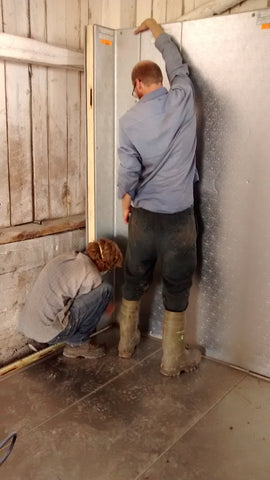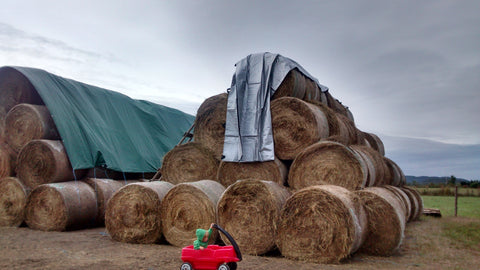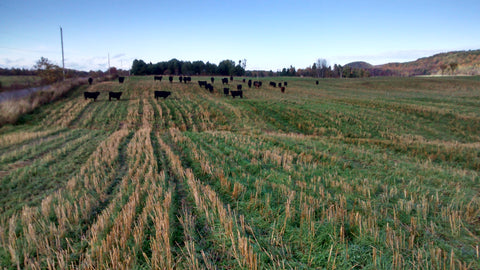
We decided to harvest 9 acres of oats that we planted — underseeded with grass — in the spring, in order to get some straw for bedding for the winter. We don’t yet have a combine and it was hard to find someone who could do the work for us; most contract workers in our area own machinery that’s suited to combining hundreds of acres in a go, not a few handfuls. A real downside to the push to “go big or go home” when you’re in agriculture is that small scale farmers, who don’t want to go big, nonetheless have a harder time accessing machinery that is suitable to their scale.

We ended up harvesting four tons of oats, much more than anticipated. As we hadn’t expected such yields, we also didn’t have a place to store the grains. Paul stayed up late to build two massive wooden crates on pallets, which he then lifted onto one of our grain wagons. Unlike our old grain silo, it was a good height for the combine. (P.S. Anyone want to buy feed oats?)

With meat deliveries starting this weekend, we’ve also had to make sure we had the freezer space to hold the meat. Paul and Danny started by giving the barn a deep clean, removing years’ worth of cobwebs, removing some of the walls and a hay rack, digging out old manure, and trucking in some sand. We then built two freezers and a cooler in our barn and have been working with our local electrician and refrigeration experts to get everything up and running.



We ended up buying the bulk of the hay we need to feed the cows and calves throughout the winter. Paul filled the hay shed and then built a pair of pyramids and covered them with the biggest tarps we have ever owned.




At this point, we’re also working on installing close to 7000 feet of water pipe to get water to the animals during the winter. The creek that has fed our pasture pumps in the spring and summer won’t do at all during the winter, so we’ve had to apply to the municipality to dig below a road, and find contractors who can do the work. The pipe needs to be between 5 and 6 feet below ground to prevent freezing, and needs to be in the ground before we have daytime frost.
We have also found the logs we need to build wind breaks for the cattle, for shelter from the winter winds. More on that once we manage to secure transport to get them to the farm.
Despite the busyness of this great winter prep, the two herds get fresh pasture every day, fences get moved, pasture pumps are moved from pasture to pasture with the herds, and the animals are counted and their health monitored.



In the next post, we’ll talk about the new abattoir we’re working with, our new sausage makers, and hopefully, we’ll have progress to report on the pipes and windbreaks.
To those receiving the first box of their share this Saturday, enjoy !
